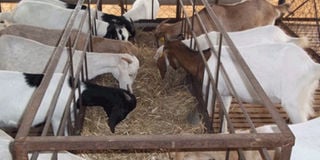Goats vs sheep rearing

Goats feeding from their paddock. File photo
Goat and lamb meat are being recognised for their nutritional value and are two of the most commonly consumed red meats around the world. Goat meat comprises 63 per cent of all red meat consumed worldwide, and is healthier than any red or white meat.
Also, because of their texture, goat and lamb is easily digested by the human stomach. Goats are easy to rear on limited land space and their meat is ideal for barbecue, stew, or burgers. Goat and sheep milk can also be processed into various forms of hard and soft cheeses.
Question is, of the two types of animals, which one is a better investment for a farmer? Here are some experiences.
Sulaiman Tulye, a sheep farmer from Entebbe explains that Ugandans have just started adopting sheep rearing but before they were ignoring the project in terms of income earning.
“You can rear sheep along with other animals or cattle, especially on subsistence scale with goats or cows because at a certain point they take the same feeding,” Tulye says.
Tulye says he decided to take on sheep rearing in 2012 after realising that it can work as a side business.
“I started sheep rearing in 2012 with two sheep. Two years later I had 20 sheep, since then, my farm has grown rapidly,” Tulye shares.
Currently, his farm has more than 100 sheep. Henry Sekamanya, a social worker, from Bukasa Muyomba village in Wakiso District rears goats as a side business.
He started with three goats but now he has more than 100 goats in a period of three years yet he is targeting to have 300 goats in two years from now.
“I started with Shs650,000 which I used to buy three goats, one billy Boer goat and two nanny Mubende goats from Mbarara District. In a space of one year, the two nannies gave birth to eight more goats,” Sekamanya says. He says you can only gain from goats when you are not profit-driven.
Diseases
Sheep and goats are generally susceptible to the same diseases, including scrapie, which is transmitted via infected placenta to genetically-susceptible offspring.
Breeds
Sekamanya says Boer goats from South Africa, Mubende and Savannah goats are the most productive goats in Uganda because they take a short time to produce, (about six months) and easy to maintain on a free range system. In sheep rearing, Tulye says Ugandans are still using local breeds known as Ankole Fat-Tailed and Dorset Horn Breed Cross sheep which are commonly reared in Mukono, Kayunga and Rakai districts.
Nutrition
Sheep and goats have similar nutrient requirements, though goats have higher maintenance requirements because they are not able to digest the cellulose of plant cell walls as well as sheep. Lambs tend to grow much faster than kids, no matter what the diet is. Sheep convert feed more efficiently. Grain-feeding is less likely to be profitable in goat (meat) production.
With the exception of a few breeds, sheep and goats fatten very differently. Goats deposit fat around their internal organs before depositing external fat over their back, ribs, and loin. Sheep deposit external fat before depositing internal fat. Finn sheep and hair sheep of tropical orgins deposit fat around their organs similarly to goats.
Benefits
Tulye says the by-products from Ugandan sheep are few compared to goats and cattle.
Sekamanya, on the other hand, says goats produce organic manure for maize and tomato growing.
He adds that you can also get money from organic manure from goats with a 100kg-sack at Shs15,000. In a week, you can collect up to six sacks of manure which is a good fertiliser.
Market for Sheep
Tulye explains that sheep is mainly sold during the Idd Adhuha period, a religious festival when Muslims sacrifice animals and events where there is a variety of roasts. Tulye sells his sheep to city abattoirs between Shs50,000 and Shs 60,000 each.
“Most farmers have ignored sheep farming because they think it’s not profitable but I have realised that if carried out on a commercial scale, a farmer can make a lot of money from it,” he says.
Social dominance
Due to their more aggressive behavior, goats will usually dominate sheep, especially if the goats have horns and the sheep are polled (hornless). However, when young bucks and rams are maintained together, rams will dominate because the ram will preemptively strike the buck in the abdomen while the buck is still in the act of rearing up.
Verdict
• A goat farm is 10 times more profitable than sheep farm.
• Sheep gives birth to 1 kid in a year whereas goat four kids in a year.
• Maturity period of sheep is 390 days whereas goat matures in 300 days.
• Goats are highly resistant to diseases as compare to sheep.
• Goat meat has very high demand unlike sheep meat.
• Marketing of goats is very easy as opposed to sheep.
• Goats require less fodder compared to sheep.
Goat Prices
Goats are sold at four months. They cost about Shs150,000. Between six to eight months, a Nanny goat costs Shs200,000 while a Billy goat is Shs250,000. A mature pure Boer Billy goat for breeding costs between Shs500,000 and 550,000 while a Nanny is between Shs250,000 and Shs300,000. The dock is about Shs700,000 and Shs1m accommodating 50 goats. Goats’ meat costs Shs15,000 per kilogramme.




